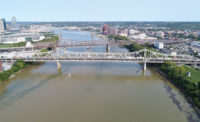Improved U.S. Infrastructure in the past several years brought its grade up in the last four years—but only to a "mediocre" C- from D+—says the American Society of Civil Engineers in its new infrastructure Report Card.
But the March 3 report also projects that the gap between infrastructure funding needs and dollars spent on those facilities will climb to $2.59 trillion over the next 10 years, from $2.1-trillion in the group's 2017 analysis.
ASCE also notes that 11 of the 17 infrastructure categories it evaluated still scored in the D range, with transit the lowest, at D-.
U.S. Transportation Secretary Pete Buttigieg said that the report card results “tell us something we already know – that we have a long way to go … that we are past the point of allowing Infrastructure Week to be a Washington punchline once again.”
[View report summary here and full report here.]
With increased funding in recent years, grades went up in aviation, drinking water, energy, inland waterways and ports infrastructure sectors, but bridges did worse in the latest review, with its grade dipping to C, from C+ in 2017—the only category to decline.
ASCE Executive Director Thomas Smith pointed to Insufficient funding from multiple sources as the prime reason for the middling C- score. “There’s a lot of different parts to this solution, however, he said, "That funding comes from federal, state, local [governments] and also the private sector.”
Some non-funding actions can have an impact, too. Smith pointed to expediting regulatory permitting that considers a project’s life-cycle costs up front, rather than just a focus on initial project expense
The report’s release comes as industry groups anxiously awaiting the release of President Joe Biden’s Build Back Better legislative proposal, which is expected to include a substantial amount of funding for infrastructure.
Biden had said he would announce the proposal in February but that date has slipped, with greater focus now on his $1.9-trillion American Rescue Plan bill, which the House has approved and the Senate has begun debating.
Noting transit’s grade of D-, transit advocates noted the importance of keeping systems running, particularly for essential workers, at a related virtual ASCE conference .
“We have an incredible opportunity to think about how we deliver transit products to the community…. rethinking policies to make transit more convenient for essential workers,” said Jeff Nelson, general manager of the Illinois-Iowa Quad Cities Metrolink.
Elizabeth Shuler, ACL-CIO secretary-treasurer, noted that many of the country's 12.5 million union workers are in frontline essential roles, “but at the same time many have experienced loss of jobs and economic fallout." Deferring maintenance and infrastructure investment has a direct negative impact every single day." Shuler cited the example of port workers “spending hours in line waiting just to do their jobs” due to traffic congestion.
She added: "That’s exactly why we need to be big and bold, pointing to America’s history of building big, including the Interstate system.
Phillip Washington, CEO of the Los Angeles County Metropolitan Transportation Authority, called for a program akin to the Works Progress Administration during the 1930s, which put 8.5 million people to work on over 1 million projects and a set up a national coordinating agency for infrastructure development and delivery.
“I often say we ought to be ashamed—we took a 30-40-year infrastructure vacation in this country,” he said, adding that ancestors "are turning over in graves because we didn’t take care of what they built.”
Noting that infrastructure encompasses not just transportation and water, but also broadband, Washington said: “Do we want kids in rural and urban areas sitting around a McDonald’s to do their homework because the wi-fi is there?”
That message rang true for virtual attendees, when the transportation session was delayed for a few minutes because the panel was knocked off line.
Maria Lehman, GHD Inc. infrastructure lead, expressed confidence that a sustained federal commitment to infrastructure investment will happen.
“I feel it in my bones this time,” she said, citing the pandemic, climate change, economic crisis, and equity. “The solution for all of these is investing in infrastructure.” She added that infrastructure “is no longer in a mid-life crisis—it’s in an old-age crisis.”
Buttigieg said lack of infrastructure investment is a disadvantage to the U.S. in the global context adding that the administration is focused right now on the recovery aspect, which includes preserving existing transit systems. While transportation will include development of “futuristic things that capture the sizzle,” such as commercial space travel, electric vehicles and drones, he said, “there is unglamorous work to do as well … it’s just as economically powerful just to fill that hole in the road.”
Asked by moderator Kristina Swallow, director of the Nevada Dept. of Transportation, if there is enough political will in government, he said, “The American people want us to do this. Infratructure is already one of the most bipartisan things this administration is taking on."
Buttigieg emphasized that “what we call freedom is inseparable from our choices about transportation infrastructure, water infrastructure, and increasingly digital infrastructure.”





Post a comment to this article
Report Abusive Comment